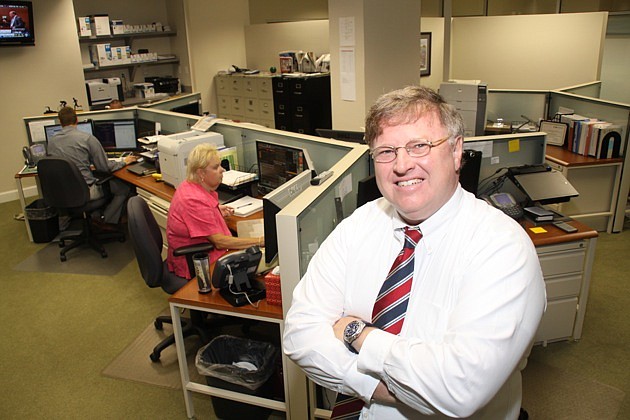REVIEW SUMMARY
Company. JKMilne Asset Management
Industry. Financial services
Key. Small boutique firms can be more nimble than their goliath competitors.
When John Milne moved his bond-management firm's headquarters to Fort Myers from Pittsburgh in 2010, he wasn't seeking sand and sun.
Milne, whose 14-hour days start at 5 a.m. managing $1.8 billion, says he discovered a large concentration of people from Tampa to Naples who sit on boards of pension funds, endowments and other institutional investors. “Amongst our clients, there are a lot of decision makers in this region,” says Milne, who researched areas as far as Scottsdale, Ariz.
This should be sweet music to economic-development boosters who want to diversify the Gulf Coast's real estate-dependent economy. Financial-service firms like JK Milne Asset Management may be among the industries that could help the area recover from the devastating downturn.
Milne is a bond-market veteran who, as president and chief investment officer of Mellon Bond Associates, part of Mellon Bank, grew that firm's assets under management to $90 billion when he left in 2003, up from $7 billion when he started there in 1985.
To grow the firm that bears his name, Milne tapped into the connections he had made while running Mellon Bond, including that firm's 900 clients. But Milne felt there was an opportunity to create a boutique firm in what he calls an “oligopoly” of a few large, dominant players. The largest of these, of course, is Pimco, which manages $1.3 trillion.
By comparison, Milne's firm manages portfolios that range in size from $4 million to $300 million, with the average at about $100 million. And he won't take on more than 25 clients, preferring to turn away prospects once he reaches that number rather than being overstretched. The hands-on Milne has an office, but he says he spends most of his time sitting at the trading desk instead. Besides being the CEO of the firm, Milne also is the firm's chief investment officer.
But there's nothing small about Milne's track record managing conservative fixed-income investments. In contrast to the stock market, good performance in the bond market is judged by hundredths of percentage points and most of Milne's strategies have exceeded their benchmarks by wide margins. For example, since inception in 2004, Milne's actively managed intermediate fixed-income strategy returned an annualized 5.55% compared with 4.75% for its Barclays Capital benchmark, according to data provided by Bogdahn Group, an investment consultant.
In 2008, after correctly anticipating the collapse of the mortgage market, Foundation & Endowment Intelligence, one of the Institutional Investor publications, named Milne its “Bond Manager of the Year.” In 2007, that honor was bestowed on Pimco.
Risk everything
A native of Long Island who started his banking career in the late 1970s with Marine Midland Bank, Milne managed fixed-income investments for Grumman Corp., now Northrop Grumman Corp., and later joined Mellon Bond Associates in 1985.
Using only his personal savings and declining outside investors or debt, Milne formed his firm in 2004. Interest rates then were relatively low and were set to rise, presenting an opportunity for a small organization like his to nimbly navigate the volatility that was sure to follow. “You risk everything,” says the conservative bond manager.
While Milne is considered an active manager, he also offers investors passive index strategies that hew to a benchmark. “Mastering the indexes gives you a leg up on active management,” he reasons.
Milne only manages money for institutional investors, such as foundations, endowments and pension funds. He has no high-net-worth clients and has no sales or marketing department.
Milne declines to name his clients, but the firm's assets under management have grown steadily to more than $1.8 billion today. Much of that growth comes from clients who entrust more of their funds with Milne over time. For example, Milne's first client invested $20 million. Today, Milne manages six portfolios with $250 million for that same client.
But Milne says he limits the number of clients to 25 because he wants to remain hands-on with a staff of eight people. Because his firm trades investment-grade bonds of the “Group of Six” developed countries, his day starts at 5 a.m. and doesn't end until the evening. “The bond market is unique in that it never closes,” Milne says.
Like most money managers, Milne charges a percentage of assets under management. For actively managing bonds, for example, his firm charges range from 0.3% to 0.5%, depending on the size of the account.
While technology helps Milne do more with fewer people, he says the software is costly. For example, one license to manage regulatory compliance issues costs $800,000 over three years.
Milne says the watershed moment for his firm was when Foundation & Endowment named him Bond Manager of the Year. “We did not know it was coming,” says Milne, who says even today that he didn't know how he was selected.
But in 2008, Milne was one of the few who moved funds out of the mortgage market and invested heavily in U.S. Treasuries. “In '08, we felt there was something wrong in the securitized market,” Milne recalls. In 2009, Milne also correctly returned to buying corporate and mortgage bonds.
Since then, Milne says his firm has chosen to temporarily close to new investors on two occasions. Managers like Milne have so-called “soft closes” so their staffs aren't overwhelmed by large inflows of money when they're successful. “We're nimble and we can move money very quickly if necessary,” Milne says.
Milne says he wants his customers to be able to reach a single contact immediately, and he can't do that effectively if he takes on too much business. “Our existing clients are using up capacity like crazy,” he says.
Certainly, with the market and political volatility in recent months, investors around the globe have shifted away from equities and into fixed-income investments. Many investors had reduced their bond allocations as stocks rose last year, but Milne says that shift is over.
Gulf Coast headquarters
Milne says Fort Myers moved to the top of his list for relocation destinations when he realized many of his clients have homes in the area. Milne was already familiar with Florida because he's owned a home in Key West for 20 years.
“Our clients are formidable sources of knowledge,” Milne says. “We don't come in with all the answers.” He says clients are scattered from Naples to Tampa along the Interstate 75 corridor.
Besides, Milne says, “The business climate is good here.” There's plenty of top-quality office space for rent at reasonable prices and the airport is convenient. “The airport is an excellent asset,” he says.
Despite the fact that Fort Myers isn't a hub for money managers, Milne says he's been impressed by the quality of job applicants. “We found no shortage of educated employees,” he says. “It's been good for us here.”
No double dip
Compared with stock investors, bond managers are notorious for forecasting gloom-and-doom scenarios.
So it's refreshing to hear John Milne say he doesn't believe the U.S. is headed for another recession. “Our view is that the real economy is in better condition than the market indicates,” says the CEO of JKMilne Asset Management in Fort Myers, an institutional bond manager who oversees more than $1.8 billion in assets.
Milne says central bankers of the leading industrialized nations are working more closely on a coordinated approach to spur a recovery than most observers give them credit.
Milne is sanguine about the recent downgrade of U.S. debt by Standard & Poor's or concerns about the U.S. dollar losing its appeal as a reserve currency. “It didn't change our world, but we are watching to make sure the [Treasury] auctions are going well,” he says.
This optimistic view of the U.S. economy is due in part to the fact that large corporations have managed well through the downturn and inflation remains in check. “Balance sheets are looking good,” Milne says.
The key now is to spur economic growth by unleashing entrepreneurs, including by lowering taxes. “Taxes are a very large burden on small business,” he says, citing his own firm's taxes as the second-largest expense after payroll. Such growth, Milne says, “would cover a multitude of sins.”
Still, Milne wouldn't be a good bond manager if he didn't worry about something. In particular, he's concerned about the possibility of stagflation, which combines slow growth and inflation. “We need the typical economic expansion of 5% to 6% GDP growth,” he says.
While he doesn't think inflation will rise significantly in the next year or so, fiscal policies compounded over the years may lead to faster price increases in the long term.
Also, Milne is concerned that market volatility will continue until the U.S. presidential election. “We may not have volatility relief for another year,” he says.






